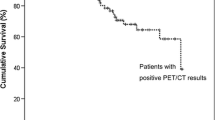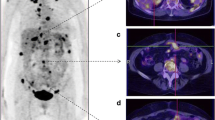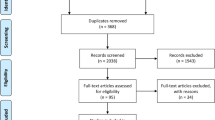Abstract
Background
To compare fusion, positron emission tomography–computed tomography (PET–CT) with CT alone in detecting ovarian carcinoma recurrence.
Methods
Fifty-one consecutive patients underwent 53 restaging PET–CT scans with a concurrent diagnostic quality CT scan. Two body imaging radiologists independently assessed the CT’s; each then teamed with a nuclear medicine specialist to review the PET–CT’s. Two teams conferred for consensus on the presence of disease in the chest, abdomen, and body overall with CT alone and with PET–CT, using a six-point reader confidence metric to determine accuracy and receiver operating characteristic (ROC) curves. Reader agreement was compared using kappa. Recurrence was determined by two gynecologic oncologists reviewing clinical records from time of presentation to at least 13 months (mean 22.7) after imaging.
Results
Recurrence was based on histopathology in 17% (9/53). Seventy-two percent (38/53) cases had recurrence, with two cases showing isolated chest recurrence. PET–CT accuracy exceeded CT for body 92% (49/53) vs. 83% (44/53), chest 96% (51/53) vs. 89% (47/53), and abdomen 91% (48/53) vs. 79% (42/53). ROC curves for PET–CT dominated that for CT alone; this difference was statistically significant for abdomen and for body overall (P < 0.01). Interobserver agreement was better for PET–CT than for CT alone.
Conclusions
PET–CT demonstrates greater accuracy and less interobserver variability than CT alone.



Similar content being viewed by others
References
American Cancer Society, Cancer Facts and Figures 2005. http://www.cancer.org/downloads/STT/CAFF2005f4PWSecured.pdf
Silverberg E, Boring CC, Squires TS (1990) Cancer statistics, 1990. CA Cancer J Clin 40:318–9
Nahhas WA (1997) Ovarian cancer. Current outlook on this deadly disease. Postgrad Med 102:112–20
Nanni C, Rubello D, Farsad M, et al. (2005) (18) F-FDG PET/CT in the evaluation of recurrent ovarian cancer: a prospective study on forty-one patients. Eur J Surg Oncol 31:792–7
Look M, Chang D, Sugarbaker PH (2004) Long-term results of cytoreductive surgery for advanced and recurrent epithelial ovarian cancers and papillary serous carcinoma of the peritoneum. Int J Gynecol Cancer 14:35–41
Niloff JM, Bast RC Jr, Schaetzl EM, et al. (1985) Predictive value of CA 125 antigen levels in second-look procedures for ovarian cancer. Am J Obstet Gynecol 151:981–6
Cho SM, Ha HK, Byun JY, et al. (2002) Usefulness of FDG PET for assessment of early recurrent epithelial ovarian cancer. AJR Am J Roentgenol 179:391–5
Makhija S, Howden N, Edwards R, et al. (2002) Positron emission tomography/computed tomography imaging for the detection of recurrent ovarian and fallopian tube carcinoma: a retrospective review. Gynecol Oncol 85:53–8
Beyer T, Townsend DW, Brun T, et al. (2000) A combined PET/CT scanner for clinical oncology. J Nucl Med 41:1369–79
Landis JR, Koch GG (1977) The measurement of observer agreement for categorical data. Biometrics 33:159–74
Zanon C, Clara R, Chiappino I, et al. (2004) Cytoreductive surgery and intraperitoneal chemohyperthermia for recurrent peritoneal carcinomatosis from ovarian cancer. World J Surg 28:1040–5
Rubin SC, Randall TC, Armstrong KA, et al. (1999) Ten-year follow-up of ovarian cancer patients after second-look laparotomy with negative findings. Obstet Gynecol 93:21–4
Skates SJ, Xu FJ, Yu YH, et al. (1995) Toward an optimal algorithm for ovarian cancer screening with longitudinal tumor markers. Cancer 76:2004–10
Hogberg T, Kagedal B (1992) Long-term follow-up of ovarian cancer with monthly determinations of serum CA125. Gynecol Oncol 46:191–8
Ferrozzi F, Bova D, De Chiara F, et al. (1998) Thin-section CT follow-up of metastatic ovarian carcinoma correlation with levels of CA-125 marker and clinical history. Clin Imaging 22:364–70
Funt SA, Hricak H, Abu-Rustum N, et al. (2004) Role of CT in the management of recurrent ovarian cancer. AJR Am J Roentgenol 182:393–8
Coakley FV, Choi PH, Gougoutas CA, et al. (2002) Peritoneal metastases: detection with spiral CT in patients with ovarian cancer. Radiology 223:495–9
Gryspeerdt S, Clabout L, Van Hoe L, et al. (1998) Intraperitoneal contrast material combined with CT for detection of peritoneal metastases of ovarian cancer. Eur J Gynaecol Oncol 19:434–7
Rubin SC, Lewis JL Jr (1988) Second-look surgery in ovarian carcinoma. Crit Rev Oncol Hematol 8:75–91
Markus JB, Somers S, O’Malley BP, et al. (1990) Double-contrast barium enema studies: effect of multiple reading on perception error. Radiology 175:155–6
Fultz PJ, Jacobs CV, Hall WJ, Gottlieb R, et al. (1999) Ovarian cancer: comparison of observer performance for four methods of interpreting CT scans. Radiology 212:401–10
Sella T, Rosenbaum E, Edelmann DZ, et al. (2001) Value of chest CT scans in routine ovarian carcinoma follow-up. AJR Am J Roentgenol 177:857–9
Sironi S, Messa C, Mangili G, et al. (2004) Integrated FDG PET/CT in patients with persistent ovarian cancer: Correlation with histologic findings. Radiology 233:433–40
Picchio M, Sironi S, Messa C, et al. (2003) Advanced ovarian carcinoma: usefulness of 18F-FDG-PET in combination with CT for lesion detection after primary treatment. Q J Nucl Med 47:77–84
Author information
Authors and Affiliations
Corresponding author
Rights and permissions
About this article
Cite this article
Sebastian, S., Lee, S.I., Horowitz, N.S. et al. PET–CT vs. CT alone in ovarian cancer recurrence. Abdom Imaging 33, 112–118 (2008). https://doi.org/10.1007/s00261-007-9218-0
Published:
Issue Date:
DOI: https://doi.org/10.1007/s00261-007-9218-0




